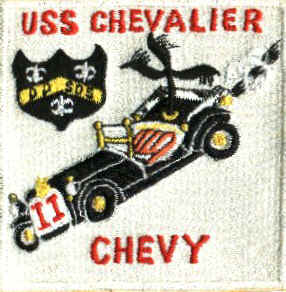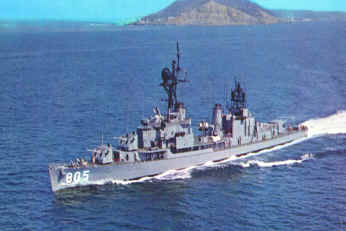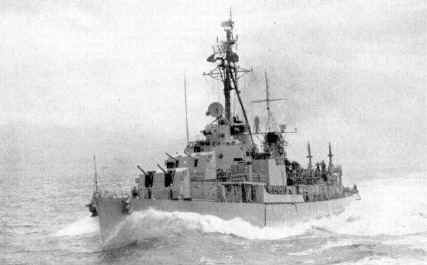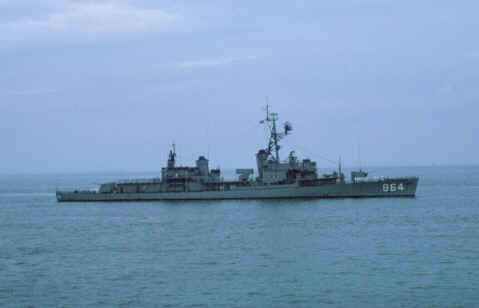|

JUNIOR OFFICERS AND CHIEF PETTY OFFICERS
By Richard H. King, CDR USNR-Ret.
At the time of this story, CDR King was LT JG, Main Propulsion
Assistant (1965-1968),
(Assistant Engineering Officer for Main Propulsion)
U.S.S. CHEVALIER (DD-805)
There is
probably no relationship more awkward than that of a junior officer
(Ensign or LTJG), usually a “division officer” on board a Navy ship, with
the Chief Petty Officer or senior Chief Petty Officer in the same Division.
Officer and senior enlisted. College
graduate and school of hard knocks and experience.
In the Army, it is 1st or 2nd Lieutenant and Master
Sergeant. The problem is the same.
The young officer doesn’t know what he is doing and the senior chief or
sergeant with up to twenty-five years experience or more is theoretically under
the direction of the junior officer who may be smart and educated, but
doesn’t know crap.
Very little is
written in military manuals about how this is supposed to work. There are a few brief paragraphs in the “Division
Officer’s Guide”, an official Naval Publication that stays about twenty
years behind the times. As an NROTC
student during the draft, I had a class or two in which a LCDR tried to impress
upon us that Chief’s were the backbone of the Navy, and needed to be treated
with utmost respect. Beyond that,
we were on our own. So, now with a
clear picture of how this was supposed to work, I embarked upon my active duty
career in 1965 aboard the USS CHEVALIER DD-805, a destroyer left over from WWII,
to fight the war in Vietnam.
Arriving on
board, on the second day, I was interviewed by the Captain.
I had already achieved two out of three “dream sheet” goals, homeport
in San Diego and a destroyer. My
third goal, to be an engineering officer, would have to wait. I would have to do penance first in operations, specifically,
electronics. Initially, the leading
ET was only a first class, so he was a bit easier to deal with.
But later he was replaced by an ETC, Chief Cline.
He was close to my age, for a CPO, and I saw talent.
Before the year was over, I wrote the recommendation that made him one of
the first W-1’s after warrants were re-discovered and brought back on line. WO1 Cline and I had lunch in the wardroom on Chevalier
shortly after he graduated from what we called Warrant Officer “knife
and fork” school. He was
one of four enlisted chiefs that made O.O.D I on the Chevalier.
Chief Cline (ETC), Chief Latshaw (STCS), Chief McGrew (RDC) and Chief
Fleming (FTGS).
After a year, I
finally got the job on the CHEVALIER that I wanted from the start: MPA (Main Propulsion Assistant).
The departing Chief Engineer, James Dee, put in a good word for me; all
the time I was in Operations, I spent as much time as I could studying the
engineering plant. Captain Kirk did
not like Engineering and he wanted me to stay in OPS, his field.
He could not understand why I wanted to move from OPS to Engineering, but
he relented.
start: MPA (Main Propulsion Assistant).
The departing Chief Engineer, James Dee, put in a good word for me; all
the time I was in Operations, I spent as much time as I could studying the
engineering plant. Captain Kirk did
not like Engineering and he wanted me to stay in OPS, his field.
He could not understand why I wanted to move from OPS to Engineering, but
he relented.
The MPA vacancy occurred
during a period of much turnover, simultaneous with a new Chief Engineer, LT Al
Sherman, and a new BTC, Chief Richard Morton.
We newcomers met together for the first time in the Engineering Log Room.
I was impressed with LT Al Sherman immediately.
Chief Richard Morton took some “adjusting”.
He was a burley salt from the West Virginia coal country rich with crude
country sayings.
For three or four months, I
was enrolled in COMCRUDESPAC ENGINEERING OFFICERS SCHOOL, and graduated with
honors. It was three
times harder than DUKE UNIVERSITY, which is not a slack school. When I returned to the ship, and assumed my new
duties, I soon discovered that BTC Richard Morton and I could work together.
We remained good friends long after we both left the Navy and were in
close communication right up to his death on May 1, 2000. The problem I
discovered quickly was the one “holdover” player from the old engineering
regime, the leading chief of “M” Division, an E-9 Master Chief, Don
Hackbarth.
Master Chief Hackbarth had
little use for junior officers. Like
children, they were to be seen but not heard.
I was willing to do it that way, up to a point.
I was already a good
manipulator of the supply system and that’s where my M Division energy
was spent. If Don Hackbarth could
get the parts, he could fix it. And
that was OK with me!
We left San Diego on 29 August
1967. We were not half way to Pearl
when Master Chief Hackbarth reported that we were salting up in the forward
plant. Upon arrival at Pearl the
forward main condenser was opened and examined closely.
In that very hot humid climate there was so much condensation that it was
impossible to identify the leaking tube. I
cannot remember whether it was Al Sherman or Chief Hackbarth that had heard of a
new way to search for condenser leaks. Take
the standard issue green “dye”, used by sonar men to mark “datum” in the
ocean, and put it into the steam side of the condenser in water and under
pressure. Then shine a “black
light” at the tube bank from the salt-water side and the leaking tube will
“glow in the dark like a “psychedelic poster” (this was the psychedelic
sixties).
We had the dye, but we
didn’t have the black light. I
knew immediately what my job was; find a black light. But Honolulu was not a psychedelic haven like San Francisco.
I started at the boiler shop at Pearl, but they didn’t have one.
So then I got in my rental car, opened up the yellow pages, and in about
four hours, I found a place that had a black light for sale.
About $35.00, if I remember correctly.
They only had one in stock.
 I returned to the ship and met with the supply officer.
How do we buy a “black light” on “open purchase”?
He warned me it would be difficult, but cut me a “purchase order”
which then had to go to the mostly civilian “supply depot” at Pearl. I met with an overweight woman in a small office with my
request. Her first
question, “How many bids do you
have?”
I returned to the ship and met with the supply officer.
How do we buy a “black light” on “open purchase”?
He warned me it would be difficult, but cut me a “purchase order”
which then had to go to the mostly civilian “supply depot” at Pearl. I met with an overweight woman in a small office with my
request. Her first
question, “How many bids do you
have?”
“Mam, it took me four hours
to find one black light in all of Honolulu, not to mention getting three bids.
Its only $35 and we have a major warship that can’t really go to sea
tomorrow without it. We will have
to file an engineering CASREP”.
“Sorry, you will have to
have three bids” “And you will have to write specifications!”
“And since a black light is not in your ship’s allowance, you will
have to write up justification papers.”
This was my first attempt to write government specifications (MILSPECS)
for a “black light, psychedelic”, but the job got done.
Actually, I wrote: “Lamp, hand held, 110 volt AC, ultraviolet light
emitting for the detection of fluorescent dyes”.
She then took it upon herself
to try to get more “bids”. Three
hours later, she still didn’t have even one competitive bid.
As the day was drawing to an end, she begrudgingly issued me the
paperwork I needed to go buy the black light.
I returned to the ship at about 1800 with the black light in hand.
And EM1 Electrician (Kavanaugh) looked at it and
immediately said we could not use it.
The cord had only two “prongs”, not three.
I told that damn electrician to take it immediately to his shop and rig
it with a grounded cord. An hour
later, we had a three-wire black light and took it into the salt-water side of
the main condenser. Chief Hackbarth
and I were side by side. The
leaking tube just “leaped out at us” with a green glow and was quickly
plugged.
After that Don Hackbarth had a
bit more respect for me. But
I had to go through a few more tests before he begrudgingly accepted me. I
can’t remember which came next, the forward generator or the
starboard shaft.
The starboard shaft is the
long shaft, running from the forward engine room through the after fire room,
then through the after engine room, then through a shaft ally, and finally to
the starboard prop. It was supported by a series of spring bearings, and one of
the spring bearings in the after fireroom was running dangerously hot.
If it got too hot, it would melt the babbit in the bearing and we would
limp back to port on one shaft. While
in port, Chief Hackbarth lifted the bearing cover and brought out all of his
precision instruments, including that blue stuff that you use to detect
irregularities. He measured and measured, and finally I asked him what
he thought was wrong. He said that
all of his measurements and tests indicated that the bearing was not aligned
perfectly with the shaft.
“But how could that be
Chief? The bearing is bolted to a
saddle, which is welded to a frame of the hull and can’t move.
This bearing has not been running hot for 22 years, only recently”.
Actually, after studying the engineering logs, I noted
that it had been running hotter than all the others for a long time,
and it just kept getting worse and worse. The
Chief showed me all the tests he had run and his measurements and finally said
“Maybe after all these years the hull of the ship has warped a bit”.
“After all, it is an old steel hull subject to a lot of stress in heavy
seas and we are talking about less than 1/64th of an inch”.
I asked, “What if we
enlarged the bolt holes a tiny bit; could you then re-align the bearing and bolt
it back down in perfect alignment?”
He replied yes, that would work, but that was against “the rules”.
I thought about it for a few minutes, considered the fact that we were
already rumored for scrapping, and finally said “Hell Chief
lets do it. I will take the
responsibility”. “What do you
need?” He replied, “some
hydraulic jacks and some shoring”. “We
will need to jack up the shaft without jacking a hole in the bottom of the
ship.”
I announced that I was on my
way to the tender to borrow some jacks. When
I got back, he had already cut some shoring and had it in place to properly distribute the weight
of the shaft. Several hours later
the job was done. We went to sea
and the overheating problem was solved. The
ship is still steaming today, 32 years later in the South Korean Navy,
presumably still with oversized bolt holes in that same spring bearing saddle.
already cut some shoring and had it in place to properly distribute the weight
of the shaft. Several hours later
the job was done. We went to sea
and the overheating problem was solved. The
ship is still steaming today, 32 years later in the South Korean Navy,
presumably still with oversized bolt holes in that same spring bearing saddle.
My third and final
“Hackbarth” test came with the failure of No. 1 generator in Khaosuing in
1968, I think. We were steaming
“auxiliary” in #1 Engine room only, when
#1 generator “tripped”. This
led to a chain reaction that is a bit hard to explain.
With the loss of power, we lost ventilation in the engine room. With the
loss of the auxiliary condenser (under the turbo generator), steam had nowhere
to go and began “popping” drains, releasing steam into the space. The temperature started to rise, and rise, and rise, finally
pegging the thermometer at 120 degrees. Not
only was the space dangerously hot, it was filled with so much steam that
visibility was only a few feet.
Man by man, the MM’s had
bailed out, but Chief Hackbarth and I were still down there trying to re-start
the generator. We tried about eight
times. To start a Sumner-Gearing
turbo generator took two men. One
had to crank like hell on a crank driven lube oil pump while the other opened
the steam valve. I did most of the
cranking; Chief Hackbarth worked the valve.
I was in my early twenties and Chief Hackbarth was in his late forties or
early fifties. On the eighth
unsuccessful attempt to re-start the generator, I looked at the Chief and became
concerned. His complexion was near
purple and he looked close to collapse. I
then gave him the first ORDER I had ever given him.
Chief, VACATE THIS SPACE NOW, THAT’S AN ORDER!
Then I also ordered out the EM3 who had hung in there with us also.
They both almost collapsed going up the ladder.
I came out last.
Once we were out and in the
passageway, I gave my second definitive order to Chief Hackbarth of my career.
I told Chief Hackbarth to go light off the after engine room and get
power restored. He did not argue a
bit. After the sweat cleared out of
my eyes, I realized that the Captain had watched the whole scene of the three of
us climbing out of the engine room hatch that was still spewing steam into the
inboard passageway.
 After power, ventilation and a condenser for excess steam were restored, Chief
Hackbarth and some MM’s worked on #1 generator all night long.
I went down there about every hour to watch his progress.
There was none. To amuse myself, I pulled the blue prints of the
generator. I saw a complicated
piston operated over speed device, and became convinced that that device was the
source of the problem. Why? Because the generator would start, but then shut itself down.
After power, ventilation and a condenser for excess steam were restored, Chief
Hackbarth and some MM’s worked on #1 generator all night long.
I went down there about every hour to watch his progress.
There was none. To amuse myself, I pulled the blue prints of the
generator. I saw a complicated
piston operated over speed device, and became convinced that that device was the
source of the problem. Why? Because the generator would start, but then shut itself down.
About three or four in the
morning, I went down and explained my theory about the over speed piston to
Master Chief Hackbarth. He was
tired, and was running out of options. Next
thing I knew, he ordered two guys to open the cap over the over speed piston.
An hour later, he reported it was bent, we had the part on board and
everything was fixed.
Master
Chief Hackbarth and I never had a problem again! I wish I could find him.
I heard he married a Japanese citizen and retired in Japan. I also heard about a year ago he put an ad in Navy Times
trying to find Chief Morton.

 

|
